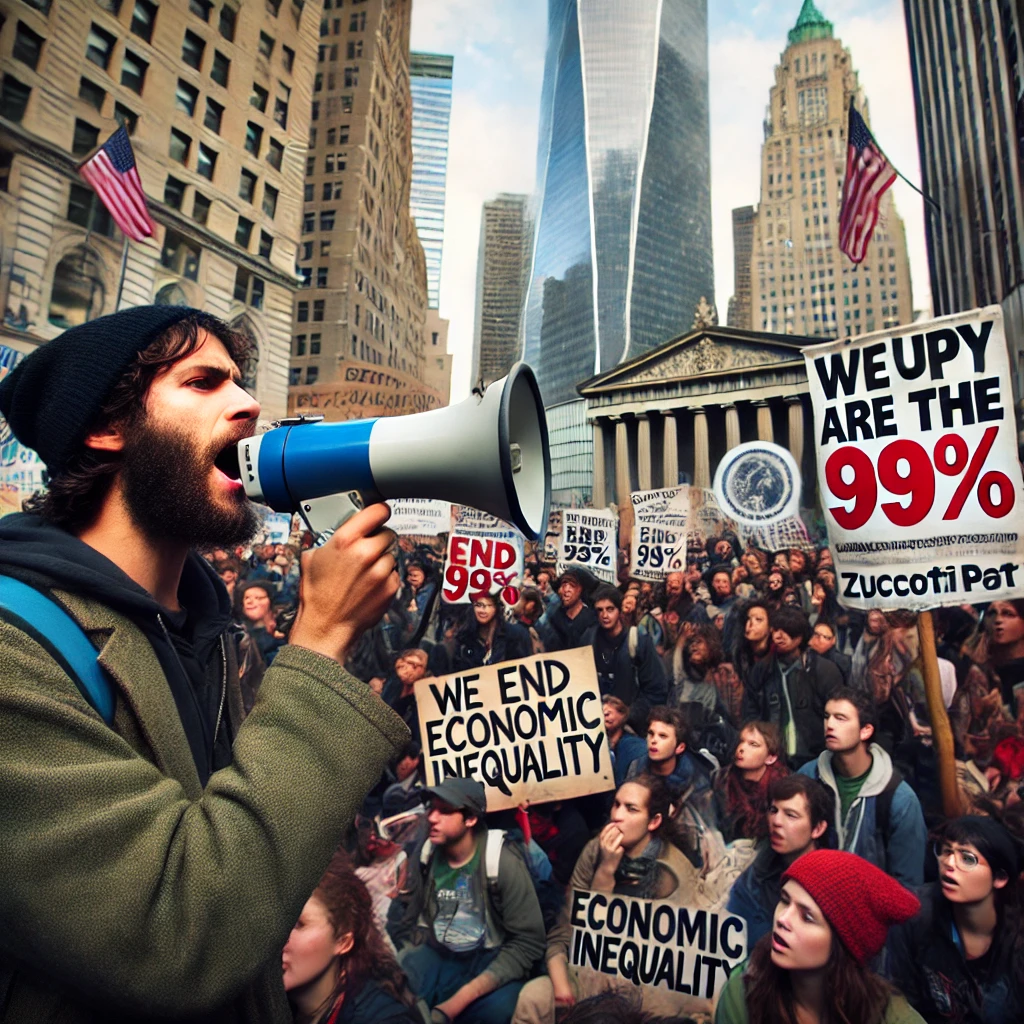On September 17, 2011, the first Occupy Wall Street (OWS) protest took place in Manhattan, marking the beginning of a movement that would capture global attention. The demonstration, which began with about 1,000 participants marching through the streets of New York City, was a response to growing concerns about corporate greed, income inequality, and the influence of money in politics. The movement’s decision to occupy Zuccotti Park symbolized its commitment to challenging the economic and social systems that many felt were failing ordinary citizens.
The Spark of a Movement
Occupy Wall Street was inspired by various social and political movements that had been gaining momentum around the world. The Arab Spring and the indignados movement in Spain had demonstrated the power of grassroots activism in challenging entrenched systems of power. Building on this momentum, a group of activists in New York City sought to address the growing economic disparities in the United States, which had become more pronounced in the years leading up to the protest.
The movement was initiated by the Canadian activist group Adbusters, which called for a peaceful occupation of Wall Street to protest against the influence of corporate money in politics and the widening gap between the wealthy and the rest of the population. The call to action resonated with a diverse group of individuals who were disillusioned with the state of the economy and the perceived corruption of financial institutions.

The Initial Protest and Occupation
On September 17, 2011, the first Occupy Wall Street protest began with a march through Manhattan’s financial district. Participants chanted slogans and carried signs that criticized corporate greed and economic inequality. The protest quickly gained attention from the media and the public, setting the stage for the next phase of the movement.
The demonstrators’ decision to occupy Zuccotti Park, a privately-owned public space near Wall Street, was a strategic choice. The park provided a central location for the protest, allowing participants to maintain a visible and sustained presence in the heart of the financial district. The occupation of the park marked the beginning of a more permanent phase of the protest, where participants set up tents, organized meetings, and engaged in discussions about their demands.
Challenges and Solidarity
The Occupy Wall Street movement faced several challenges from the outset. Organizing a large-scale protest in a densely populated urban area presented logistical difficulties, and the movement’s leaders had to navigate complex legal and regulatory issues. Additionally, maintaining a long-term occupation in the park required resources and coordination, which the movement’s organizers had to address.
Despite these challenges, the movement quickly gained support from various sectors of society. Activists, community organizers, and concerned citizens joined the protest, bringing diverse perspectives and skills to the cause. The solidarity displayed by participants was a testament to the widespread dissatisfaction with the status quo and the desire for change.
The Spread of the Movement
The impact of Occupy Wall Street extended far beyond the confines of Zuccotti Park. The movement’s message resonated with people across the United States and around the world, leading to the establishment of similar occupations and protests in other cities. The slogan “We are the 99%” became a powerful symbol of the movement’s critique of economic inequality and the concentration of wealth among a small elite.
Occupy protests emerged in cities such as Los Angeles, Chicago, and London, demonstrating the global appeal of the movement’s message. The widespread nature of the protests highlighted the universal concerns about economic injustice and the need for systemic change.
Media Coverage and Public Perception
The media played a significant role in shaping the public’s perception of Occupy Wall Street. The movement received extensive coverage, with news outlets reporting on the protests, the occupation of Zuccotti Park, and the various issues raised by demonstrators. The media attention helped to amplify the movement’s message and draw attention to the concerns of those involved.
However, the coverage also brought challenges. The portrayal of the movement varied, with some media outlets focusing on the clashes between protesters and law enforcement, while others highlighted the movement’s goals and demands. The diverse range of media representations influenced how the public perceived the movement and its objectives.

Impact on Policy and Politics
The Occupy Wall Street movement had a notable impact on policy discussions and political discourse. The movement’s emphasis on economic inequality and corporate influence contributed to a broader conversation about the need for financial reform and greater accountability. While the immediate policy changes were limited, the movement’s advocacy helped to raise awareness about issues related to economic justice and the influence of money in politics.
The movement also influenced the political landscape by inspiring new forms of activism and engagement. The use of social media and digital platforms to organize and communicate became a model for other movements and campaigns, demonstrating the potential for grassroots organizing in the digital age.
Legacy and Continued Relevance
The legacy of Occupy Wall Street endures through its impact on public discourse and activism. The movement’s focus on income inequality and corporate influence continues to resonate in contemporary discussions about economic and social justice. The principles and strategies employed by Occupy Wall Street have influenced subsequent movements and campaigns, highlighting the ongoing relevance of its message.
While the physical occupation of Zuccotti Park may have ended, the ideas and discussions sparked by Occupy Wall Street remain significant. The movement’s emphasis on challenging systemic inequality and advocating for change continues to inspire activists and citizens around the world.
Criticisms and Reflections
Occupy Wall Street faced criticisms from various quarters, including concerns about the movement’s organization, leadership, and specific demands. Some critics argued that the movement lacked clear goals and a coherent strategy, while others questioned the feasibility of its proposals.
Despite these criticisms, the movement’s ability to mobilize people and draw attention to important issues was a notable achievement. The discussions and debates generated by Occupy Wall Street contributed to a broader understanding of the complexities of economic and social inequality.

Lasting Impact
The lasting impact of Occupy Wall Street is evident in its influence on both activism and public discourse. The movement’s emphasis on economic justice and its use of digital tools for organizing have left a significant mark on contemporary activism. The ideas and principles championed by Occupy Wall Street continue to resonate in ongoing efforts to address systemic issues and advocate for change.
Occupy Wall Street’s legacy serves as a reminder of the power of grassroots movements to challenge entrenched systems and promote meaningful dialogue about social and economic issues. The movement’s impact on the national and global stage underscores the enduring relevance of its message and the potential for collective action to drive change.
